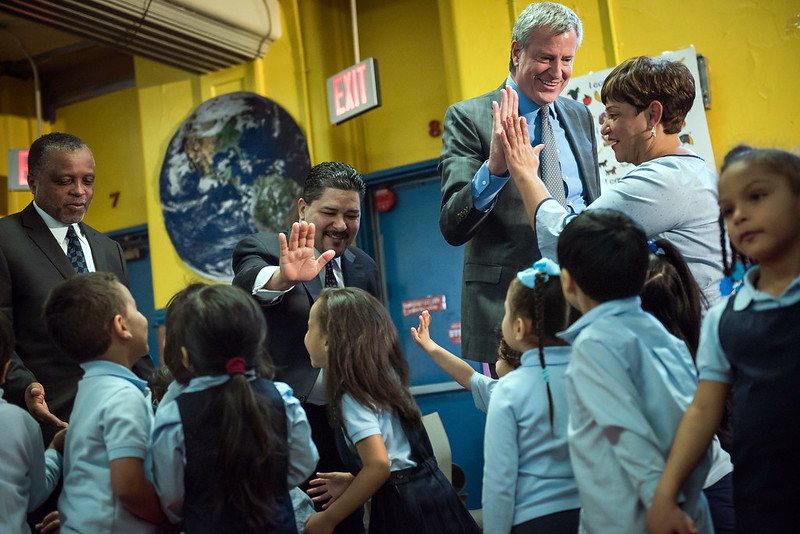
DOE Chancellor Carranza & Mayor de Blasio (photo: Ed Reed/Mayor's Office)
The Department of Education rolled out new standardized testing for thousands of students across New York City last month. For now, the new tests are supposedly targeted to low-performing (aka low-scoring) schools, but all signs point to the expansion of additional standardized testing citywide.
More standardized testing is the exact opposite of what New York City should be doing to help students and, if anything, these new tests could actually hurt our most vulnerable students. Piling on tests is not going to solve any of the problems our struggling students face -- problems like homelessness, learning disabilities, structural racism, and lack of resources. If anything, it will make school even more frustrating and unengaging for children than it already is.
Although it may come as a surprise to the Department of Education, children have social-emotional needs. They are not little robots whose brains we can endlessly reprogram. They need to have fun, they need to feel capable, and they need to feel like they belong. By forcing schools to administer even more tests and report scores multiple times a year, we risk making school even less welcoming for children, particularly for those who already struggle academically. A friend of mine who had to recently administer new tests to her fourth-graders told me that one of her students said “I feel like a dead fish” after completing his test.
No nine-year-old should use the word “dead” when describing their experience in school.
More standardized testing also runs counter to Chancellor Richard Carranza’s stated goal of bringing Culturally Responsive Education (CRE) into every classroom. First of all, standardized tests, by definition, are typically not culturally responsive; often test texts feature only typically white names or use touchpoints that most New York City children can’t relate to, like farms and forests.
There is also the issue of time: standardized testing and test prep eats up hours of the school day that could be used for culturally responsive activities like those in social studies, the arts, collaborative projects, or community building. With this new testing rollout, elementary school students will spend 12 days taking standardized tests over the school year. Middle and high school students will spend even more days on exams. Factor in weeks of test prep and that is well over a month of school lost to the least culturally responsive activity there is -- non-interactive, undifferentiated standardized testing.
Standardized tests are usually neither accessible nor helpful to immigrant students, who are required to take state English Language Arts exams after only one year in the United States. Some of these children may have not even been in school before immigrating to the United States, but after only one year living in New York City, they must endure hours of silently staring at multiple choice questions that will in no way help them learn a new language. Needless to say, this is culturally exclusive, not inclusive.
So what would actually help meet the academic and social-emotional needs of struggling students across the city and foster true culturally-responsive learning?
Smaller class sizes.
Unlike more standardized tests, reducing class sizes would actually make it easier for teachers to get to know their students, build community, and implement culturally-responsive practices in their classrooms. Smaller classes are also proven to help children grow academically. That’s why teachers across the country are striking for smaller classes and why if you were to ask any teacher whether the difference between 32 (the current cap for elementary school) and 25 or even 20 children impacts student achievement and classroom culture, you’d get a resounding “yes.”
Last year we had school on a snowy day right before a break. I had only 13 or 14 kids in a class. Everyone was happy. There were no fights; no other serious behavior problems. I had time to help every student one-on-one. The kids were calm and productive instead of overstimulated or understimulated. At one point, one of my third-grade students with learning disabilities said, “Ms. Olenick, this is the first time I’ve ever finished all of my work without needing extra time.” There is a reason why private school class sizes are almost universally kept to below 20 students, often with an assistant teacher: class size matters.
The DOE claims it doesn’t plan to spend additional money on this testing rollout. But there is no doubt that creating and evaluating tests taken by thousands -- if not ultimately hundreds of thousands -- of students will require staff time and resources. If the DOE has extra cash on hand and actually wants to help all children learn, it should use the resources not for more monotonous, culturally-unresponsive testing, but to shrink class sizes so that every child in New York City gets the support they need to grow academically, socially, and emotionally.
***
Liat Olenick is a public school science teacher at an elementary school in Brooklyn. She is also the co-President of activist organization Indivisible Nation BK. On Twitter @Liat_RO.
***
Have an op-ed idea or submission for Gotham Gazette? Email This email address is being protected from spambots. You need JavaScript enabled to view it.




